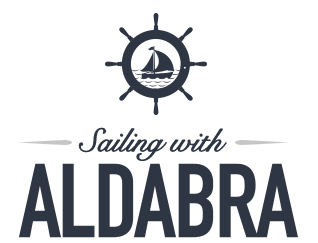Well, I guess it’s time for an update. I’ll be leaving New Zealand soon, bound for Minerva Reef and then Fiji.
So here is the long rundown of my time in New Zealand since arriving back here at the end of January. I’ll break this visit into three phases: On the boat in Whangarei Marina in the Town Basin, on the hard in the Riverside Drive Marina Boatyard, and back in the water in the Port Nikau Marina.
During the first phase, in the Whangarei Marina, the weather was mostly pleasant, sometimes muggy during the day but cool in the mornings and evenings.
The first thing I did upon returning was to buy a used car, a 2007 Honda Civic. The paint was cracking and coming off on many parts of the car, but it ran well except for faulty air conditioning, which didn’t really bother me that much. My plan was to sell the car when I left to the same dealer who sold it to me. I expected to recover about half the cost, which was fine because I didn’t spend that much on it. He told me that If I bought a more expensive car, I would still only get about half back, so buying this car was sort of a no-brainer.
Once I became mobile, I started getting around to chandleries and hardware stores. The chandleries didn’t seem as well stocked as West Marine, but they had a lot of gear and the main one I frequented, AllMarine, would order whatever I needed.
I worked with a man by the name of Tristan Campbell, who works at AllMarine and has his own boat-management business called BoatSmart HQ. He looked after Aldabra while I was in California. Upon my return he helped me purchase gear and find people to work on the boat. He found an electronics/electrician technician, a sailmaker and a rigger, among others.
The dinghy was losing air before we left in November, and the leak became significant while I was away. After a few informative discussions with Tim from Northland Inflatables, I paddled the dinghy down river at high tide to pull the boat out at a little “beach” and wheeled it to Tim’s shop. He spent a bit of time trying to find the leak. At first it was worrying because a non-obvious leak is far more expensive to fix. But in the end, he discovered a very obvious leak on the bottom of the tube. I think I know which coral reef attacked it. Once Tim found the leak, I left the boat with him.
Another important thing I wanted to do was get the boat attached to a battery charger, working off the marina’s shore power. It took a long time to identify the right equipment, which even though new, had to then be tested by an electrical services company before being put in use. After a couple of weeks, I finally had power to the batteries, which meant I could use more refrigeration and power tools. It also meant that I could remove the solar panels from the boat in preparation for putting new ones on. My solar panels had been underperforming, so I was hoping that new ones would give me a boost. The truth is that I keep putting new energy hogs on the boat, which is why it’s hard to keep up with the demand. (Starlink is the newest energy hog, but refrigeration and the autopilot are big contributors to the deficit.)
There were some big projects I wanted to have done while in New Zealand, but in Whangarei, the tradespeople are really busy, so it’s hard to find some skill sets. I did manage to line up people to make new canvas for the boat, a dodger and bimini and a new cover for the dinghy. Their work was to begin later in March.
Riggers are very hard to line up in Whangarei, at least at the busy time of year, but Tristan managed to make arrangements with one, Charlie, who would begin later.
While waiting on the arrangements for work to be done, I did some projects of my own, such as making new covers for the fenders. Another project was to make sure that my OpenCPN navigation software was ready with satellite charts for navigating Fijian waters, which can be quite treacherous because regular charts don’t show a lot of the reef hazards. That project took a long time for two reasons. One is that I have so little storage left on the PC that I have to clean up the hard drive every time I download a set of charts. The other is that I was confused about the process of setting up the charts. I was very pleased once I got that all sorted out.
One other thing I did during that time was to go down to Auckland for a couple of days to take a refresher course on emergency offshore medicine. Because we’ve had such good luck on Aldabra, I haven’t used any of the skills I learned before leaving the U.S. So, it was good to practice those skills again.
Besides working on the little projects, which took way too much time to complete, I found some nice walks. First, I was walking in a loop that goes up, across and down the river by the marina. Then I started taking trails that start near the marina and go up to higher elevations and beautifully scenic settings. The walks took you through Kauri forests with lots of fern trees. It could be really hot in town but the walks were very shaded and cool.
By hanging out in the marina to get work done, I was missing out on two activities. One was to explore the northern part of New Zealand by boat. I was seeing posts from people who were spending their New Zealand summer discovering gorgeous anchorages surrounded by beautiful landscapes and interesting towns. The other was to travel around New Zealand by car, which many cruisers were doing. I’m sad that wasn’t seizing these opportunities, but New Zealand is a good place to ensure that the boat is ready for some more seasons in the tropics. I’m toying with the idea of returning to New Zealand next year without the boat to travel by land.
The second phase of my stay here began shortly after Pat, my brother-in-law, arrived on February 24th. During that weekend, we started some projects. (Running a solar panel wire, installing new faucets and drains in the heads.) But on Monday, we walked over to talk to Terry at Alloy Stainless about doing some metal repairs on Aldabra. In talking to Terry and the Riverside Drive Marina Boatyard manager, Karl, it was decided that we would immediately bring Aldabra over to haul out in the yard. Pat and I walked back to the marina, let the marina office know what we were doing, and motored downriver the short distance to the yard. It was a bit tricky because the prop was coated with barnacles, so steering was difficult. But we managed to get to get into the slings without incident. We were then hoisted out of the water and put on a hard stand right in front of the metalworks building.
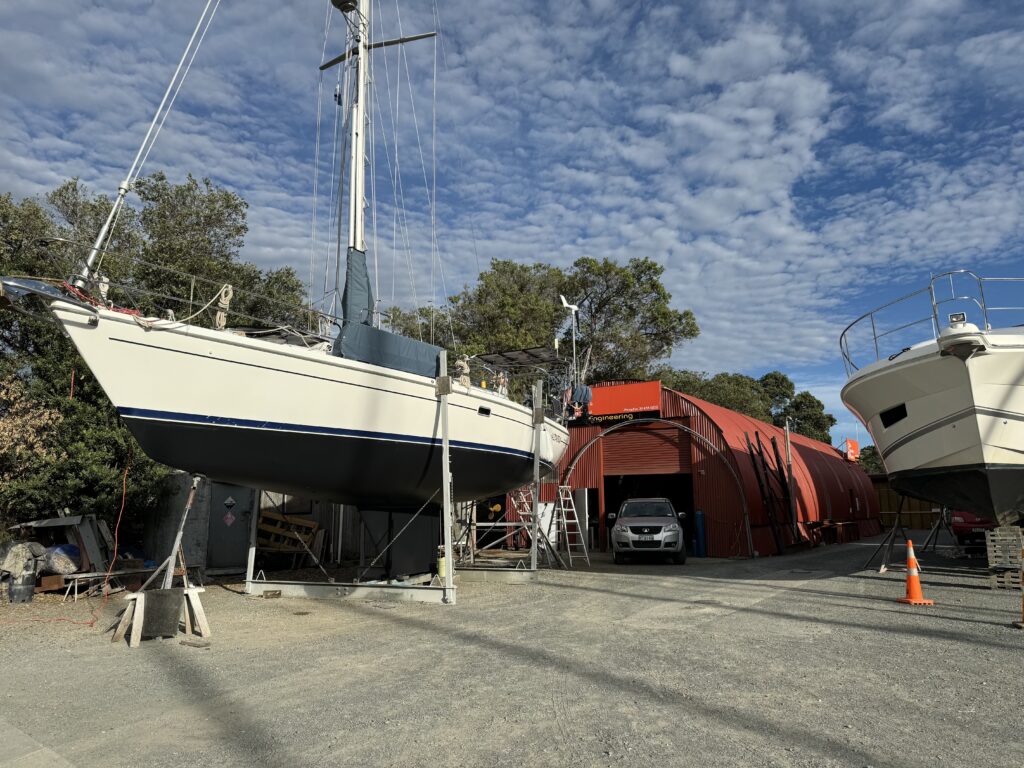
Aldabra on the hard in front of the metalworks shop
And that began the phase of living in the boatyard for a little over a month. Pat was here for the first two weeks, before going traveling with my sister on the South Island. About this time, the weather was starting to get ominously cooler. We got a lot of projects done. And the professionals in the yard got a lot of projects done. It’s hard to say enough good things about the marine tradespeople here in New Zealand once you are part of their work schedule. They are kind, thoughtful and competent. Here’s what’s the professionals did in the yard:
- Three cracks in the arch welded and then reinforcing arms added to the base of the arch to provide more strength
- A strengthening metal tube on the bow replaced
- Two stanchions on the port side rewelded
- A frame built and installed for the new solar panels on the arch
- A frame modified for the new solar panels on the dodger
- Support built for the two new solar panels on the rails so they can pivot up and down
- Bottom sanded and painted
- Hull cleaned and polished
- PropSpeed painted onto the shaft and prop to keep growth at bay
- Rudder removed from boat and rebuilt
- Boat measured for all the new canvas (dinghy taken to shop for the canvas work)
- New light installed for LPG solenoid switch at the panel
- House batteries tested (and found healthy) and new starter battery installed
- Software updates installed for B&G electronics
- Stern light moved farther aft on the arch so that it doesn’t reflect back on the arch
- Measurements for new rigging wire ordered and parts for the furling system ordered
- Outboard motor for dinghy serviced
- Rebuilt rudder installed
Here is what Pat and I did while the boat was in the yard:
- Cleaned most of the tools with phosphoric acid
- Unbolted four stanchions from the deck and then rebedded them after two of them were rewelded
- Cleaned up all the parts associated with the rudder and steering, re-oiled the pulleys and chain. Removed the old packing material in preparation for new packing material and grease to be installed with the rudder
- Pumped up the accumulator tank for the watermaker, cleaned the water strainer and changed the carbon filter
- Removed the rusty anchor chain from the boat and put it in the scrap heap
- Cleaned the anchor locker
- Serviced and rebedded the anchor windlass, with a new gypsy
- Installed new anchor chain and rope, marked the chain with paint
- Installed forward-scanning sonar transducer, cleaned up paddle wheel for speed sensor and cleaned all thru-hulls of dead sea critters
- Removed mast boot
- Repacked stuffing gland for prop shaft
- Put new hose clamps on many hoses throughout the boat
- Spent some time at the top of the mast running the main halyard back into the mast after accidently letting it run out
- Cleaned rust off of the hull and polished the stainless steel railings and fittings
- Removed the seal from the aft-compartment portlight, cleaned the sealant off the portlight and put in a new seal
The rebuilt rudder arrived back at the boatyard on Tuesday, March 28. The rudder was rebuilt by Terry of Alloy Stainless and Craig of Northland Boat Repairs. The yard put the boat in the slings and Patrick of Future Classics boatworks installed the rudder and re-connected all the steering parts. The boat then spent the night in the slings and was put back in the water first thing on Wednesday morning. Tristan came to help and we motored the boat downriver to the Port Nikau Marina.
As soon as I got to Port Nikau, Whangarei Marine Services came to service the diesel engine. Working conditions were good in the mornings but the wind came up mercilessly in the afternoons. I managed to get a few things done, such as servicing and replacing the pump in the aft head and running up a couple of new halyards.
On Sunday, my friends Ian and Laura on Rala came to the marina and helped me move the boat to the working dock near the marina. We took the mainsail off the boat and then went for a nice walk and lunch. When I returned to the boat, the riggers Charlie, Alexis and Ian, were already preparing the boat for the mast to be removed. On Monday, I had the really fun job of cleaning the bilge and tracing the wires that run down the mast, because they would need to be disconnected to pull the mast.
On Tuesday, the crane came to remove Aldabra’s and Nereida’s masts. (Nereida is owned by Jeanne Socrates, who is the oldest woman to sail non-stop, unassisted around the world.)
Getting ready to pull Jeanne’s mast
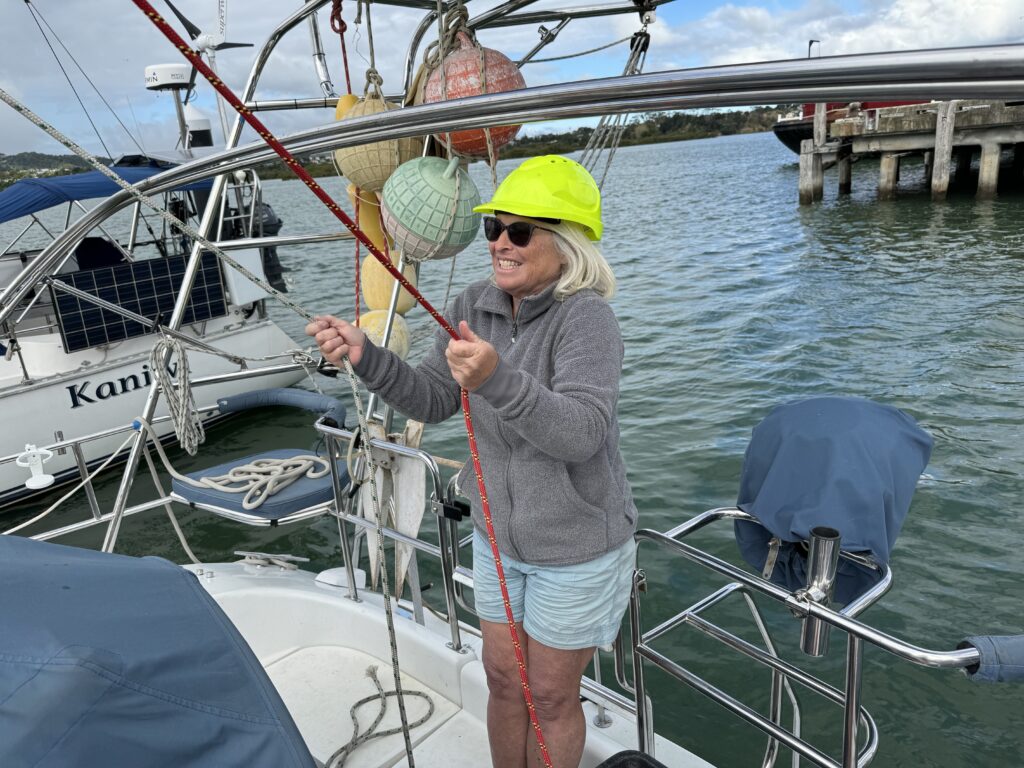
My job was to hold the tag lines while the mast was being pulled out
Once the mast was off, I stayed a few more days at the working dock, and then Ian and Laura helped me move the boat back to the original berth on Pier C. The boat stayed there until it was time to put the mast back in a few weeks later. Meanwhile, lots of work got done:
- Whangarei Marine Services took the heat exchanger out for cleaning and then reinstalled it. They also ordered a new radiator cap for me and aligned the motor mounts.
- Nick of Canvas and Covers installed the new bimini, dodger and clear side curtains, and delivered the dinghy back with new chaps.
- Calibre Sails installed reef points for a third reef on the mainsail
- The mast was cleaned up and polished, new fittings installed as necessary, including newly manufactured tips for two of the spreaders and new sheeves manufactured for the top of the mast. Also new fittings were installed for where the halyards exit the mast.
- A new deck light was installed on the mast
- All new standing rigging was installed
- Several new halyards and lines installed
- New reefing lines were installed in the boom
- The jib furler was rebuilt
- The traveler car was rebuilt
- New wedges were manufactured to support the mast once it was re-stepped
- A pin on the boom vang was machined
- The solar panels were wired to the controllers
- I drove to Auckland and picked up the liferaft after it was serviced and repacked.
- Two more stanchions broke and were re-welded, then we re-bedded the stanchions
- The mast boot was secured around the mast collar after amalgamated tape was wrapped tightly around the mast and the opening
- New mirrors were installed in the heads
While all this was going on, Ian and Laura relocated to Port Nikau so they could get a rigging inspection. They ended up on Pier C so it was nice to have them as neighbors. The three of us also got a chance to hang out with Dale and Katrina on Womble. We all got a nice hike in together.
We made friends with some of the people who live and/or work in Port Nikau. Ian and Rachel of Gypsea Lane were particularly welcoming and included us in the the social events with other liveaboards. They’re part of a really nice community of fun people.
During this time, my crew members, Stephanie and Johno joined the boat and joined in on the boat chores, including cooking some prepared meals to be frozen for the passage to Fiji. On Thursday, April 25, we moved the boat back to the working dock and the mast was re-stepped the next day. We continued doing chores while the final pieces of the rigging were were completed.
Aldabra’s mast being moved by crane to the boat to be re-stepped
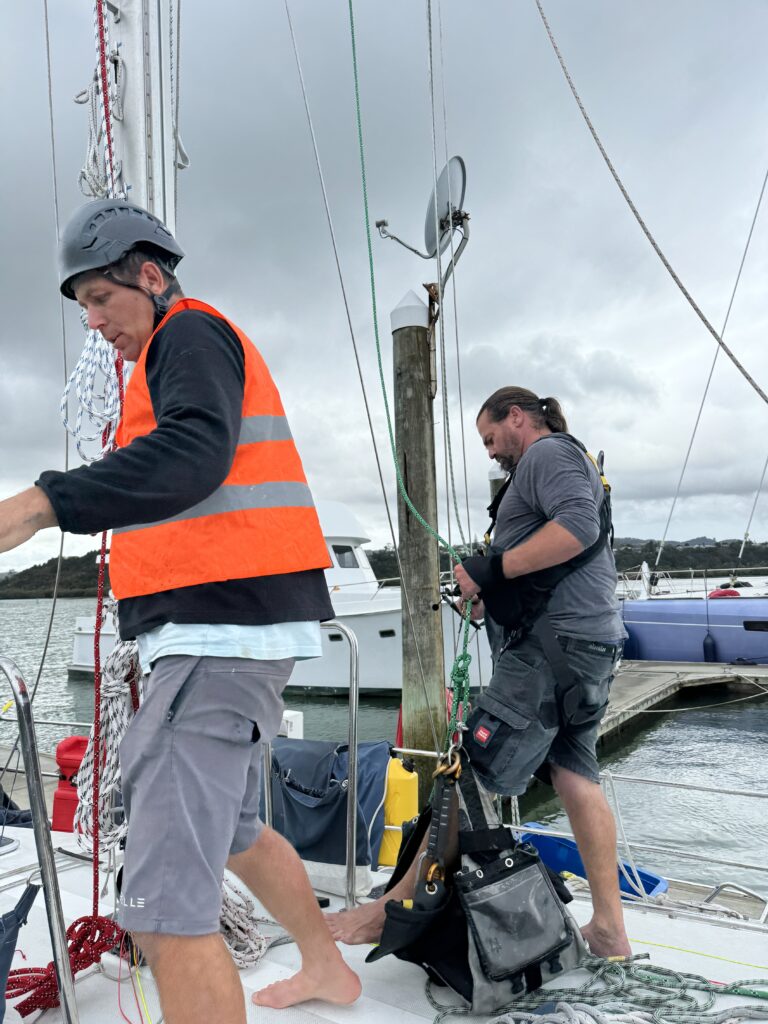
Charlie and Alexis putting the rigging back together after the mast went in
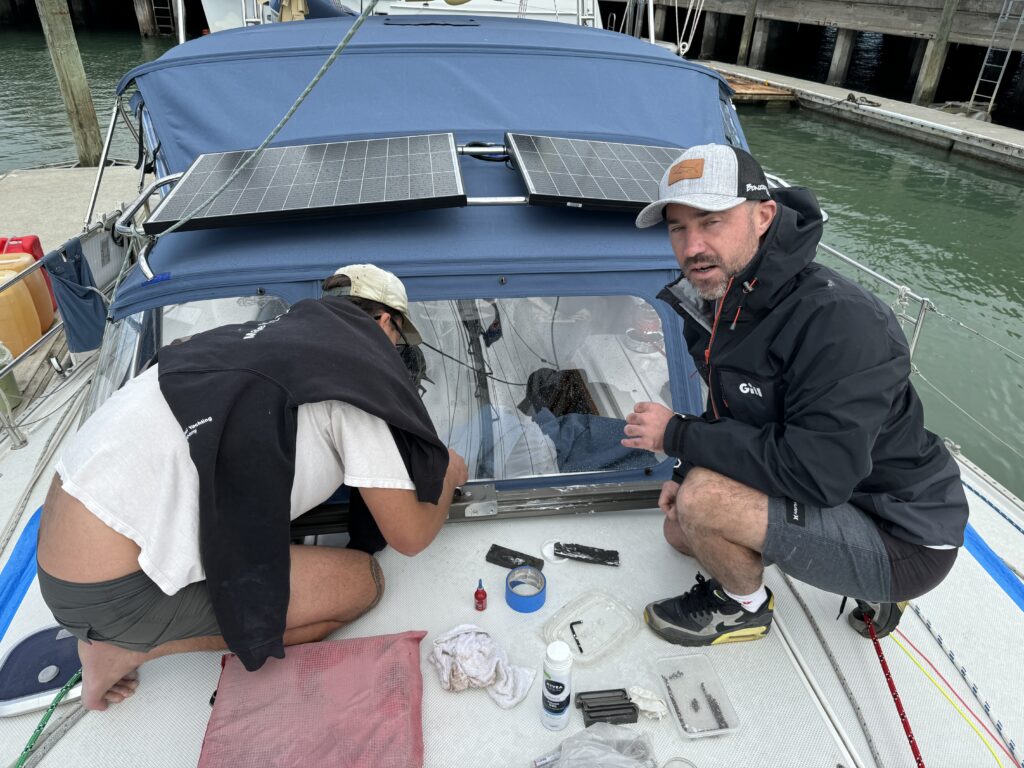
Johno and Tristan working on the traveler car.
On Thursday, May 2, we drove up to Opua for a training session by Citizens of the Sea on how we would take DNA samples from the water each day on our passage to Fiji. After staying for the Citizens of the Sea launch event that night, we drove back to Port Nikau for more work on the boat.
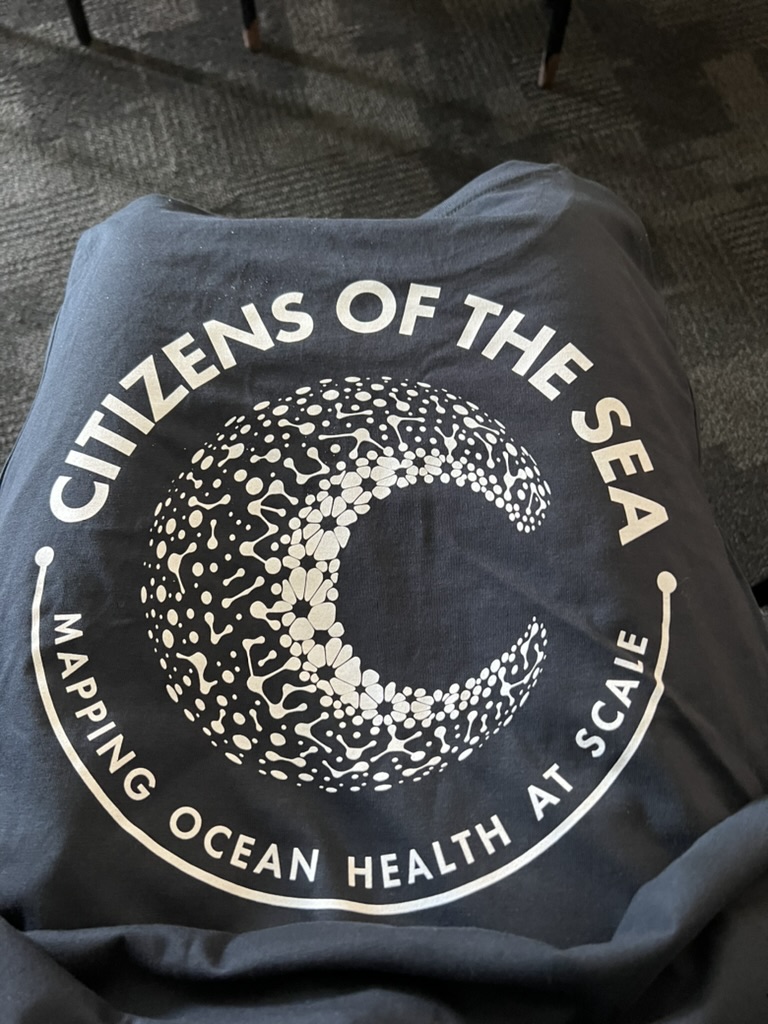
On Friday, we delivered the car back to the dealer who sold it to me and rented a car from the marina. We then worked with Charlie the rigger on the reefing system and the lines running through the boom. On Saturday, Johno and I drove back up to Opua for a briefing on Fiji, put on by the Island Cruising Rally, of which we are a part. During the afternoon, I hung out with Debbie from Thursday’s Child, another California boat, and she showed me sights around Opua, including the towns of Paihia and Kerikeri, and a couple of the local waterfalls.
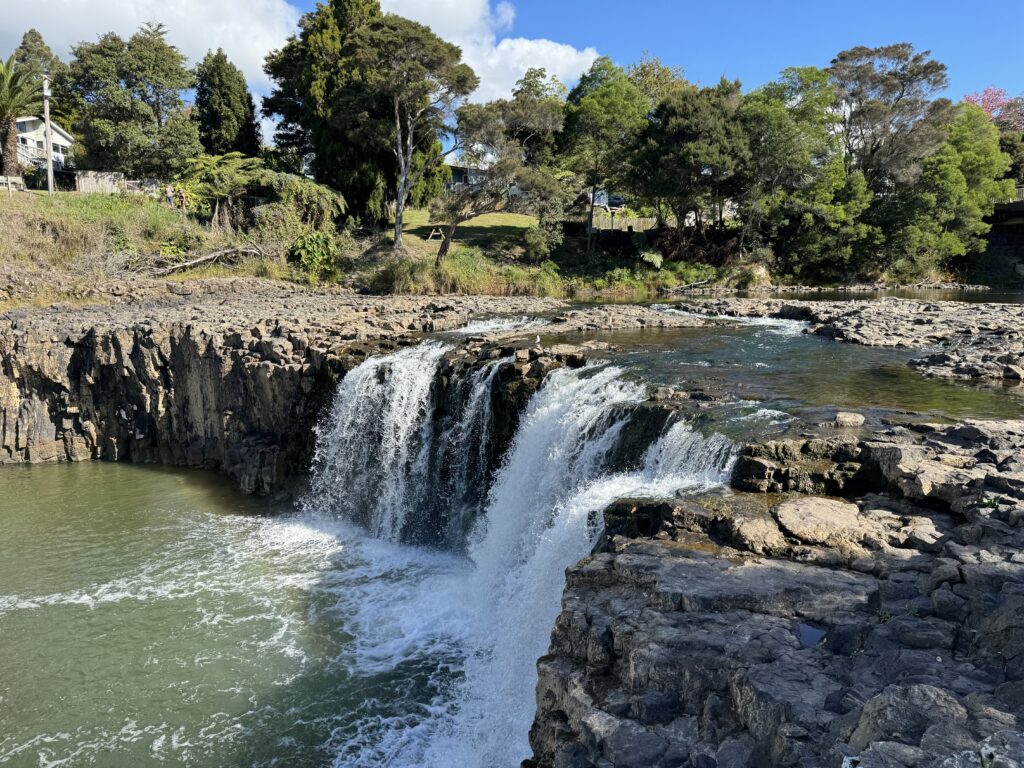
I drove back to Port Nikau that night and Johno stayed on Thursday’s Child. Meanwhile, Stephanie had stayed back on Aldabra while riggers Charlie and Alexis put the boom and the mainsail back on the boat, and installed the runners for the inner forestay.
On Sunday and Monday, we continued with final preparations for departure, casting off the docklines at 5:00 p.m. on Monday. It was rather emotional for me because I had grown quite fond of several people in Port Nikau. Seeing us off that evening was Blair, the very kind and thoughtful marina manager, Charlie our very busy, solutions-oriented rigger who was also entertaining and warm-hearted, and Tristan, who was such a help to me from the very beginning.
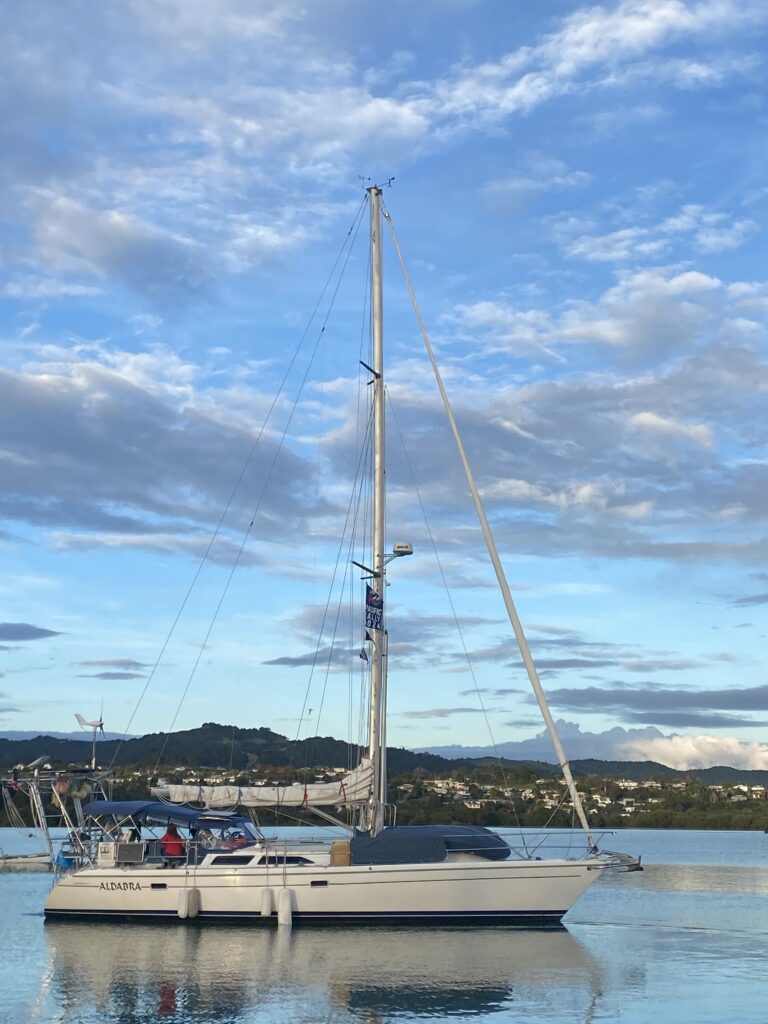
As we departed from Port Nikau, we discovered that we had no GPS signal on our chartplotter. Johno drove the boat using my iPad for navigation while Stephanie and I replaced a cable that restored the GPS. We didn’t know that we needed to restart the entire B&G system after replacing the cable, so we were without wind instruments all night as we motored north to Opua.
The overnight trip north was uneventful and we arrived at the dock a little after 9:00 a.m., where Ray, Debbie and Dana from Thursday’s Child helped us with our dock lines. Johno then went up the mast to check on the wind instruments. Once it was clear that they were properly connected at the top of the mast, we restarted the system and began getting wind speed and direction readings. Whew.
After getting settled into the Bay of Islands Marina in Opua, we did a few additional chores for passage preparation, and caught up with old friends, including Jaime and Fiona on Szel, Alex and Yvette on Blue Beryl, Dale and Katrina on Womble, and Chip and Kristina on Second Set. We’ve also met new people who are part of the rally with us. With the help of Predictwind and our weather router, John Martin, we were scheduled to depart for Minerva Reef this Saturday, tomorrow. A lot of other boats left today, which also seemed like a good time to leave. Shortly after all the boats left, we were alerted by John Martin that predictions for our departure had changed, so we are on hold for a few more days.
It’s brutally cold and windy here and we’re all looking forward to a warmer climate. The plan is to get to Minerva Reef and hang out for a few days and catch some lobster. We’ll then head north to Savusavu on the south side of Vanua Levu in Fiji.
